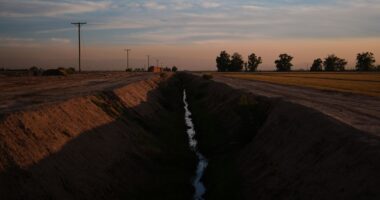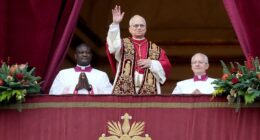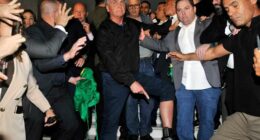Share this @internewscast.com
SHOCKING footage from the first megafire of the year shows the terrifying reality crews are facing as they continue to battle the raging inferno.
The Dragon Bravo Fire in Arizona, ignited by lightning on July 4, has been burning for nearly a month and still threatens the Grand Canyon.
It has already incinerated the Grand Canyon Lodge, an iconic tourist location on the North Rim that first opening in 1928.
Heartbreaking images show the historic lodge engulfed by flames with officials from the national park saying they have been “devastated by the loss”.
Other structures were destroyed including the North Rim visitor Center and a number of cabins.
The blaze officially achieved “megafire” status on Friday, officials confirmed.
It comes as it is now over 105,000 acres in size, making it the largest wildfire in the continental United States so far this year.
Having already destroyed approximately 100 structures, this blaze is the largest to impact the Grand Canyon National Park since 1984 and ranks as the 10th biggest wildfire in Arizona since 1990.
Timelapse videos reveal orange smoke and vapors rising into the atmosphere above the trees, strong enough to develop its own weather pattern.
“These fires can generate storms, produce lightning, or even tornadoes,” commented the Southwest Area Incident Management Team 2, which is coordinating the firefighting efforts, on Facebook.
As of Saturday, the inferno was over 114,500 acres in size – almost three times bigger than Washington DC.
While crews desperately battle the flames officials say it is still expected to grow thanks to heavy winds, high temperatures, and dry conditions.
The Kaibab National Forest, located both north and south of the Grand Canyon, reported that more than 1,180 individuals are combating the flames, with 11% of the fire under control as of August 2.
“At night, the flames are visible. During the day, you can see plumes of smoke,” Lisa Jennings, spokesperson for the Southwest Area Team, described the view from the South Rim, 11 miles away.
Fire Behavior Analyst Arthur Gonzales gave an update on the fire saying that the north perimeter was causing a concern for “rapid fire spread” due to the combination of winds and dry land.
He detailed how embers can be “lofted over containment lines or down into additional fuels ahead of the fire”.
“We’re at a 100% chance today that any ember that hits those fuels will take,” he warned on Saturday.
Meanwhile, the southwest flank of the inferno on the North Rim of Grand Canyon and at the Kaibab National Forest is “well-established over the rim edge” making it even more difficult to tackle.
This area of the fire is being further encouraged by 100 degree temperatures in the Grand Canyon and could spread west by half a mile, Gonzales said.
The National Weather Service has issued an Extreme Heat Warning until Friday.
“We’re kind of locked in a dry, breezy, abnormally hot pattern because our monsoon hasn’t showed up,” Benjamin Peterson, a meteorologist with the National Weather Service office in Flagstaff, told the New York Times.
As efforts continue to dampen and extinguish the fire, the North Rim of the Grand Canyon National Park will remain closed for the rest of the 2025 season.
Meanwhile, Arizona Governor Katie Hobbs has launched a probe into the fire after the decision was made early on to have a “controlled burn”.
This is a technique often to try to prevent other fires by burning up the vegetation that fuels major fires but strong winds on July 11 saw the fire exceed containment lines and burn the Grand Canyon lodge and other buildings.
The Dragon Bravo Fire is second to the Klikhtentotzna fire in Yukon-Koyukuk, Alaska, that is currently the largest in the country.
It has been raging for over a month and covers over 118,000 acres as of Saturday.
















